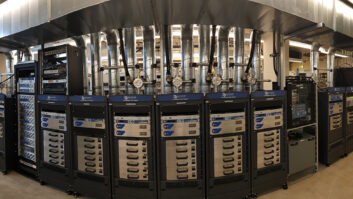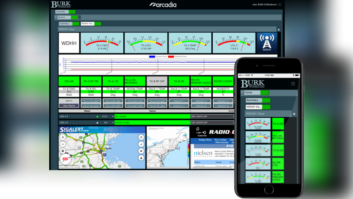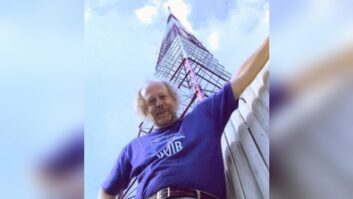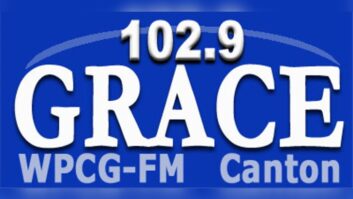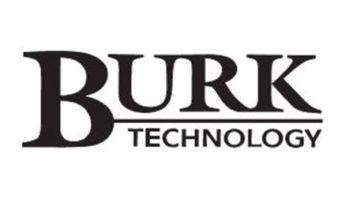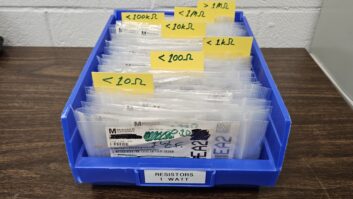He was well on his way to a college major in physics but found the material not sufficiently interesting, so he ended up with a double major in constitutional history and journalism.
That curiosity and blend of interests reflect the intellectual ferment that is John Kean, 2017 recipient of the NAB Radio Engineering Achievement Award.

While attending the University of Washington in Seattle, Kean joined with fellow students in the School of Journalism to gain Board of Regent approval for a student FM station. He prepared the FCC application, built the transmitter facility and helped build the studio. This shows him tuning the transmitter.
In two stints at NPR, Kean served as a senior technologist and helped establish NPR Labs. He has worked for consulting firms Jules Cohen & Associates and Moffet, Larson & Johnson, and now is a consultant with Cavell Mertz & Associates, as well as his own practice. He’s been active in the IEEE Broadcast Symposium and the Washington Section of the Audio Engineering Society.
It’s a career path of significant accomplishments of his own as well as contact with many well-known, even legendary, engineers.
Kean’s interest in radio and broadcast engineering began when he was attending the University of Washington, although more from extracurricular activities than formal academic studies.

When Eric Small moved his business back east, John Kean became chief engineer of KBZT(FM), “K-BEST” in San Diego.
“The interest in broadcasting developed through my work as manager of the student radio station, KCMU. I filed the FCC application and paper work to get a Class D FM license, as well as doing much of the studio construction and all of the transmitter and STL.”
At the same time, Kean was working six nights a week as an announcer for KUOW(FM), a 100 kW public station in Seattle. He made friends with the chief engineer Hal Syrstad, who offered Kean advice on the application process and eventually donated some equipment to help the startup operation.
After graduation, Kean was asked by the Regional Library for the Blind to build a radio reading service that would air on a subcarrier of KUOW, the Evergreen Radio Reading Service. The project lasted about four years; then he worked for the Corporation for Public Broadcasting, investigating multipath performance of FM systems. He soon was contacted by Eric Small, who convinced him to join up with Eric Small & Associates and relocate from Seattle to San Francisco.

With Mike Starling, right, in the original RF laboratory of NPR Labs.
“At that time, Eric was working closely with Bob Orban on the development of the Optimod 8000,” Kean recalls. “I became the first customer service engineer for Optimod. The 8000t was unlike any processor that came before, and a lot of engineers didn’t quite know what to make of it. I got a lot of questions like, ‘How do I connect my CBS Volumax to the Optimod?’”
When Small elected to move his business to New Jersey, Kean stayed on the West Coast and took a position as chief engineer of KDTZ(FM) in San Diego. His first task was moving the studios out of a church basement and into the suburbs.
“The station turned out to be very successful. They were often tied for first place in Arbitron, and working there was really a great experience.”
GOING DIGITAL

Kean built an advanced audio testing lab at NPR, which led to studies for the Consumer Technology Association and others.
In 1980, Kean heard from Dick Cassidy, who offered him a job with NPR. He made the move to Washington, where he stayed until 1986. His work — which included developing rules for protecting TV Channel 6 while allowing maximum power for educational FMs — brought him in contact with Jules Cohen, who offered him a position.
“Jules was amazing,” recalls Kean. “He was a brilliant man.” Cohen’s firm was called only half-jokingly a “finishing school” for D.C. consultants. Kean subsequently went to work at Moffet, Larson & Johnson, where he had the opportunity to travel around the world while performing advanced engineering studies; that was followed by four years as director of wireless architecture for XO Communications, a nationwide provider of data and IP services.

Among regular projects at Cavell Mertz, Kean has helped in the development of an RF measurement drone, which provides precision measurement of television and FM signals from transmitting antennas. This was presented at the Broadcast Engineering and IT Conference. Here the vehicle is shown in early flight testing.
Then he got the call from Mike Starling, asking if he wanted to return to NPR to join a new venture called NPR Labs. Kean signed on as chief technologist and was there from its launch in 2004 until his position was eliminated during budget cuts in 2015.
Kean R&D work, much of which can still be seen at http://nprlabs.org/research, included development of an interactive high-resolution online mapping system for FM and DTV; coverage increase as provided by elevated IBOC digital sideband power, including asymmetrical sidebands; determination of potential interference to consumer DTV receivers from NCE FM stations, related to the old FCC 73.525 rules based on analog sets; AICCS, a study of compatibility between IBOC and analog FM, including host compatibility and first-adjacent interference susceptibility; and algorithms for multipath prediction, both analog FM and IBOC digital, with synchronous FM booster networks and development of geographic mapping tools.

John Kean is shown at the Grand Canyon with his wife Renee last year.
Doug Vernier, founder, president and senior engineer of V-Soft Communications recalls, “When NPR Labs was established, John’s name and the lab’s were nearly synonymous. He was the first in the industry to introduce cognitive testing to determine the level of interference perceived by a listener.”
Starling, now general manager of WHCP(LP), noted the breadth of Kean’s activities.
“John founded the Evergreen Radio Reading Service in Seattle, which positioned him perfectly as the engineer to call away from his perch at XO Communications to test IBOC compatibility with SCAs. My first formal encounter with John was when NPR engaged him to conduct the final substantive testing required for the NRSC’s ultimate IBOC endorsement. His legendary work with Bob Orban and Eric Small stand alongside his patient hours of weekly phone tutelage to engineers around the globe on all matters of audio and RF technology. He is a broadcast engineer’s broadcast engineer.”




The work at Moffet, Larson & Johnson led to many adventures and travel opportunities, including international projects.
Although Kean is probably best known for his work with HD Radio, he has been heavily involved with audio too. He considers himself to have a “kind of schizophrenic personality” when it comes to engineering projects and interests.
“I can be heavily involved with RF, but then switch to audio for a while, then go back to RF. Recently, audio loudness standards has become a real passion for me.”
His work on managing loudness for streaming audio began about five years ago. “I was asked by NPR Digital Media to choose the best audio codec for Internet streaming. In the course of that study, I realized that there was an even more challenging problem to solve, namely the mismatch in loudness from stream-to-stream and from content-to-content. And in doing that research, I discovered that a loudness metering standard had already been developed in Europe and was really the solution to our problem.”
Loudness measurement, he says, is important for audio production and distribution because it solves that mismatch.
“When you figure out the loudness mismatch, a lot of other things fall into place. You don’t need as much audio processing, and the listeners tend to like it better as well.”
John W. Reiser witnessed the impact of Kean’s work when Reiser was senior engineer at the Federal Communications Commission.
“I first met John Kean through the activities of the Washington Section of the Audio Engineering Society. At the time, the FCC was considering relaxing its rules to permit non-commercial stations to lease their FM subcarrier capacity, in order to financially support their operations while still providing existing radio reading services to the blind.
“One option was to permit the use of higher-frequency subcarriers and also increase the maximum FM modulation level so the main program modulation would not be reduced,” Reiser said. “John was the lead researcher in evaluating these FM modulation standards, and I was the FCC engineer responsible for reviewing the proposed changes, as well as implementing the rule changes. John’s research resulted in FCC rules being adopted that not only benefited the public and educational stations, but also the commercial FM broadcasters as well. This is only one of his many legacy projects that have benefited broadcasting worldwide.”
DRONES AND MORE
HONOR ROLL
Recipients of the NAB Engineering Achievement Award are listed here. Beginning in 1991, radio and TV winners were named; radio winners are shown.
1959 John T. Wilner
1960 T.A.M. Craven
1961 Raymond F. Guy
1962 Ralph N. Harmon
1963 Dr. George R. Town
1964 John H. DeWitt Jr.
1965 Edward W. Allen Jr.
1966 Carl J. Meyers
1967 Robert M. Morris
1968 Howard A. Chinn
1969 Jarrett L. Hathaway
1970 Philip Whitney
1971 Benjamin Wolfe
1972 John M. Sherman
1973 A. James Ebel
1974 Joseph B. Epperson
1975 John D. Silva
1976 Dr. Frank G. Kear
1977 Daniel H. Smith
1978 John A. Moseley
1979 Robert W. Flanders
1980 James D. Parker
1981 Wallace E. Johnson
1982 Julius Barnathan
1983 Joseph Flaherty
1984 Otis S. Freeman
1985 Carl E. Smith
1986 Dr. George Brown
1987 Renville H. McMann
1988 Jules Cohen
1989 William Connolly
1990 Hilmer Swanson
1991 George Marti
1992 Edward Edison & Robert L. Hammett
1993 Robert M. Silliman
1994 Charles T. Morgan
1995 Robert Orban
1996 Ogden Prestholdt
1997 George Jacobs
1998 John Battison
1999 Geoffrey Mendenhall
2000 Michael Dorrough
2001 Arno Meyer
2002 Paul Schafer
2003 John W. Reiser
2004 E. Glynn Walden
2005 Milford Smith
2006 Benjamin Dawson & Ronald Rackley
2007 Louis A. King
2008 Thomas B. Silliman
2009 Jack Sellmeyer
2010 Steve Church
2011 L. Robert du Treil
2012 Paul Brenner
2013 Frank Foti
2014 Jeff Littlejohn
2015 Thomas F. King
2016 Andy Laird
2017 John Kean
Geoff Mendenhall, technology advisor for Gates Air, said, “I believe that one of the most important contributions that John has made to the advancement of FM IBOC HD Radio was his work on the maximum allowable, symmetrical and asymmetrical IBOC digital sideband levels, taking into account the D/U ratios on either side of the IBOC channel. His development of the online sideband increase calculator was a significant aid to broadcasters in determining how much they could increase their digital sideband levels.”
NOT TOO LOUD, NOW
When he’s not working on broadcast-related projects, Kean, age 66, has been catching up on work around the house, as well as taking hikes through the Grand Canyon and Philmont Scout Ranch in New Mexico.
He has thought of retirement, but: “I am thoroughly enjoying work with Cavell Mertz, especially the recent research on the use of drones for measurement of broadcast antennas. Also, I’m active on several AES committees. There’s plenty for me to do in the foreseeable future.”
Doug Vernier told Radio World that Kean has been tireless in spreading his knowledge “far beyond the public radio industry,” with numerous presentations for NAB engineering conferences, IEEE and AES. He has also been a contributing author for three NAB Engineering Handbooks and is a frequent contributor to Radio World Engineering Extra.
An indication of Kean’s experience and stature is that he has worked with at least six other recipients of the NAB Radio Engineering Achievement Award: Wallace Johnson, Jules Cohen, Bob Orban, Geoff Mendenhall, John Reiser and Ben Dawson. There are no doubt many more whose influential careers have entwined with his.
Since 1959, the NAB has recognized the work of exceptional broadcast engineers, one in radio, and one in television, with the Engineering Achievement Awards. John Lyons of The Durst Organization is this year’s recipient of the NAB Television Engineering Achievement Award, and Catherine Badalamente of the Graham Media Group is honored with the Digital Leadership Award. Recipients are nominated by their peers for significant contributions to advancing the state of the art in broadcast engineering.
Tom Vernon is a longtime contributor to Radio World. He profiled Tom Mintner here in February; see radioworld.com, keyword Mintner.





